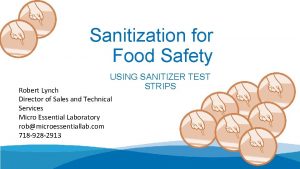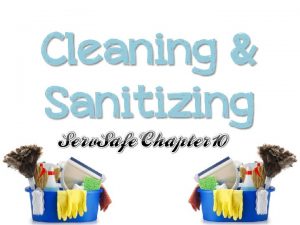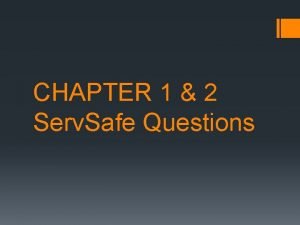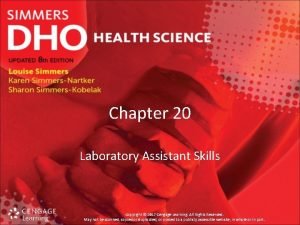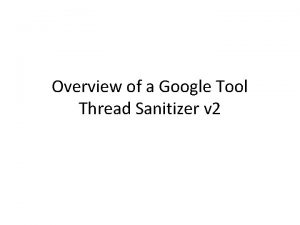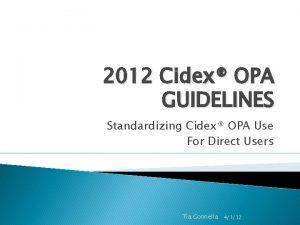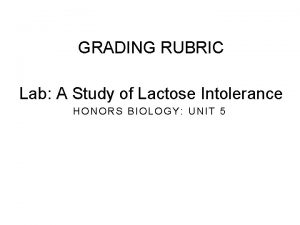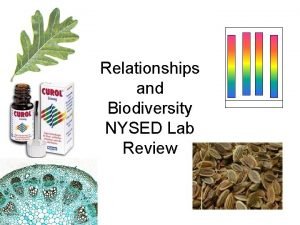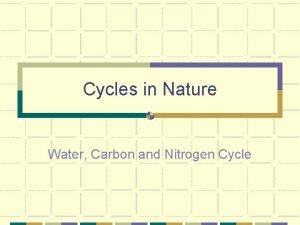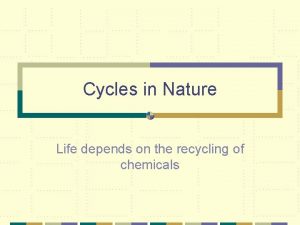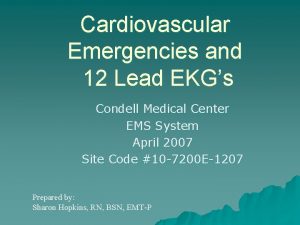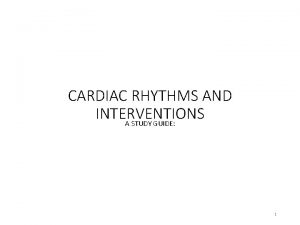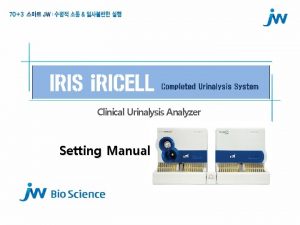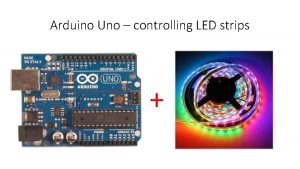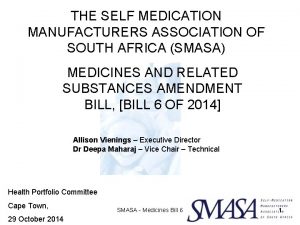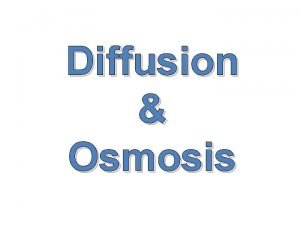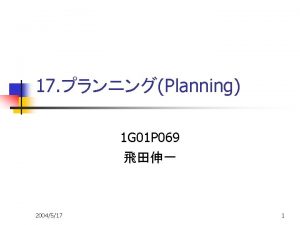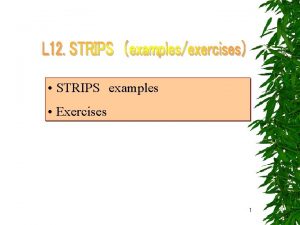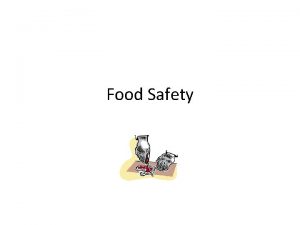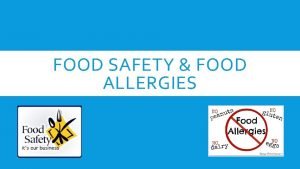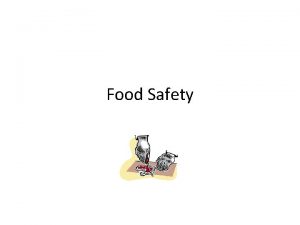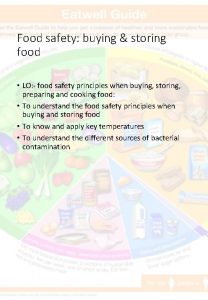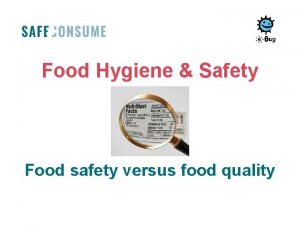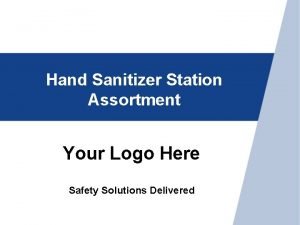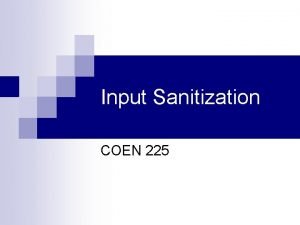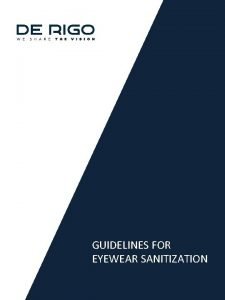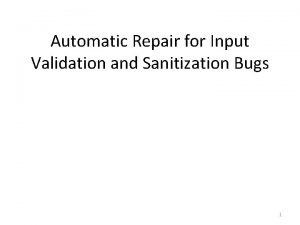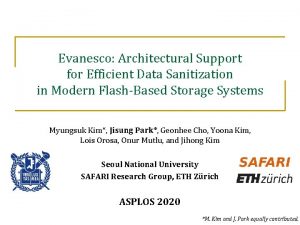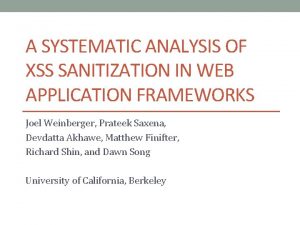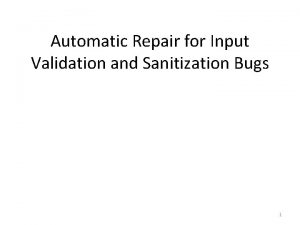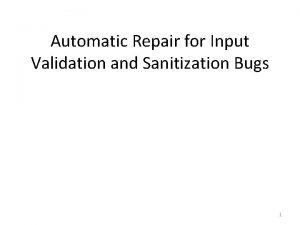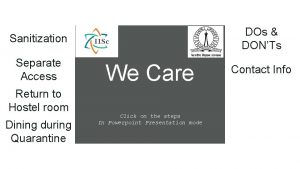Sanitization for Food Safety USING SANITIZER TEST STRIPS







































- Slides: 39

Sanitization for Food Safety USING SANITIZER TEST STRIPS Robert Lynch Director of Sales and Technical Services Micro Essential Laboratory rob@microessentiallab. com 718 -928 -2913

Honor Wall of real-life victims of foodborne illness. Stopfoodborneillness. org

Welcome TRAINING OUTLINE 1. The Who 2. The Why 3. The What 4. The Where 5. The When 6. The How © 2017 Micro. Essential. Laboratory

The Who 1. Us: Micro Essential Laboratory, Inc. . 2. The Regulator - Federal, State, Local 3. Industry - Retailers © 2017 Micro. Essential. Laboratory

The Why ü To prevent, eliminate or reduce pathogens to a safe level. ü To protect public health and prevent foodborne illness. ü Regulations 1. Chemical sanitizers require minimum concentrations to ensure proper sanitization. (Food Code § 4 -501. 114) 2. Too much sanitizer could be toxic. (Food Code § 7 -204. 11) © 2017 Micro. Essential. Laboratory

The What Cleaning-the removal of dirt, food, or other soil from a surface, usually accomplished by a detergent Sanitizing-the removal of pathogens to a safe level, defined as a 5 log reduction, or removal of 99. 999% of organisms. Sanitizing only works when it follows proper cleaning!! © 2017 Micro. Essential. Laboratory

The What Disinfection- eliminates nearly all recognized pathogenic microorganisms but not necessarily all microbial forms (e. g. , bacterial spores) on inanimate objects. Sterilization- is a procedure that kills all microorganisms, including high numbers of bacterial endospores. Sterilization can be accomplished by heat, ethylene oxide gas, hydrogen peroxide gas, plasma, ozone, and radiation (in industry). © 2017 Micro. Essential. Laboratory

The What Temperature Sanitization (Heat Sanitizing) in retail food facilities is accomplished by: üHot water manual operations by immersion at temperature of 171°F (77°C) for at least 30 seconds. üHot water mechanical operations by being cycled through conveyor warewashing equipment at a temperature of 180°F (82°C. ). This manifold temperature which will yield a plate temperature of 160°F or above. © 2017 Micro. Essential. Laboratory

The What Chemical Sanitization- Manual or Mechanical üChlorine üQuaternary Ammonium Compounds (Quats) üIodine üOther © 2017 Micro. Essential. Laboratory

The What CHLORINE Concentration Range (ppm) Minimum Temperature p. H 10 or less Minimum Temperature p. H 8 or less 25 -49 120◦F (49◦C) 50 -99 100◦F (38◦C) 75◦F (24◦C) 100 55◦F (13◦C) © 2017 Micro. Essential. Laboratory

The What As p. H increases, chlorine becomes less effective as a sanitizer. ØChlorine itself is a strong base – has a high p. H ( 7 – 14) ØIf the p. H of the solution is high or basic, chlorine won’t “react. ” ØIt takes a lower p. H, more of an acidic environment, to get the chlorine to react in the water and actually do what we want it to do; that is, sanitize. © 2017 Micro. Essential. Laboratory

The What Chlorine ü IS effective for most bacteria, viruses, fungi, and bacterial spores ü IS NOT the best choice to breakdown organic matter and biofilms (groups of microbial cells held together by a kind of cellulose; basically microbial slime). These require scrubbing, acidic cleansers, and quats. © 2017 Micro. Essential. Laboratory

The What QUATERNARY AMMONIUM COMPOUNDS 1. Surfactant and Sanitizer 2. 2 -Chain quats Shorter chain Second generation Exact measurement, 200 ppm 3. 4 -chain quats Longer chain Fourth generation Broad range of measurement, 150 -400 ppm © 2017 Micro. Essential. Laboratory

The What QUATS MUST: 1. Be tested at a temperature of 65°F - 75°F (18°C - 24°C) for greatest accuracy (this may not be the same as the “use” temperature. ) 2. Have a concentration as specified under the FDA Food Code § 7 -204. 11 and as indicated by the manufacturer’s use directions included in the labeling 3. Be used only in water with 500 MG/L hardness or less or in water having a hardness no greater than specified by the EPA-registered label use instructions because the surfactant makes the quat more sensitive to water hardness levels. © 2017 Micro. Essential. Laboratory

The What QUAT BINDING: If a cloth is soaking in solution, there may not be enough sanitizer for it to be effective in reducing the number of pathogens. • Quats bind to fabrics (microfiber cloths bind less than cotton) • Sanitizer is “in the fabric” no longer in the solution • Leads to an ineffective level of sanitization on the surface/equipment • The Quat solution need to be tested just prior to use © 2017 Micro. Essential. Laboratory

The What When using quats, it is important to … üSpray, wipe around lightly and air-dry, üdip and air-dry, or üsoak an item to be sanitized in a solution that has been tested and confirmed to be at the correct concentration. Then air-dry. © 2017 Micro. Essential. Laboratory

The What SOLUTION Chlorine Quats PROS CONS Corrosive and irritating to the skin, effectiveness Highly effective on a wide depends on solution p. H variety of bacteria, and exposure to light; inexpensive, and not loses effectiveness with affected by water biofilms/organic matter, hardness requiring more frequent water changes Nontoxic, odorless, Works slower than colorless, noncorrosive, chlorine, temperature nonirritating, effective sensitive, ineffective with over a wide p. H range hard water and some and with organic matter, detergents heat stable © 2017 Micro. Essential. Laboratory

The What TEST KITS 1. QT-10, or “Quat Test – 10” is formulated for 2 -chain quat compounds with measurements in the range of 0 - 400 ppm. 2. QT-40 is a quat test paper for 4 -chain quats with measurements of 0 - 500 ppm. 3. QAC is a general, non-specific match to test for all quats. 4. Chlorine test papers provide a means to measure the concentration of free available chlorine in solution. Measurements range from 10 - 200 ppm. © 2017 Micro. Essential. Laboratory

What are we hearing from the regulators? 1. 2. New Chemicals being seen in use; • Hypochlorous Acid (HOCL) • Hydrogen Peroxide • Peracetic Acid • High Range Quat solutions and sprays (Lysol) Disinfecting vs Sanitizing food contact surfaces • Food service establishments think using more chemical is better • Use of RTU products is on the rise, but are these solutions OK to use? © 2017 Micro. Essential. Laboratory

The Where 1. Where is sanitization needed? 2. Where are sanitizer solutions located? © 2017 Micro. Essential. Laboratory

The When to Test 1. Buckets= Every 2 to 4 hours or more as needed to keep the water clean and the sanitizer effective in use. 2. Spray Bottles-1 time/day at minimum 3. Dishmachines- 1 time/day at minimum 4. Pre-soaked disposable sanitizer wipes- the bucket should be tested each shift © 2017 Micro. Essential. Laboratory

The When © 2017 Micro. Essential. Laboratory

The How © 2017 Micro. Essential. Laboratory

The How © 2017 Micro. Essential. Laboratory

The How © 2017 Micro. Essential. Laboratory

The How © 2017 Micro. Essential. Laboratory

The How © 2017 Micro. Essential. Laboratory

The How © 2017 Micro. Essential. Laboratory

The How Follow instructions on kit: 1. Water temperature for TESTING 2. Foam and swishing 3. Time 4. Blotting 5. Color chart 6. Reading the results © 2017 Micro. Essential. Laboratory

The How - Quats © 2017 Micro. Essential. Laboratory

No testing bubbles! No swishing the strip around! The How - Quats © 2017 Micro. Essential. Laboratory

The How - Quats © 2017 Micro. Essential. Laboratory

The How - Quats © 2017 Micro. Essential. Laboratory

The How - Chlorine © 2017 Micro. Essential. Laboratory

p. H The How - Chlorine © 2017 Micro. Essential. Laboratory

The How - Chlorine © 2017 Micro. Essential. Laboratory

The How - Chlorine © 2017 Micro. Essential. Laboratory

The How © 2017 Micro. Essential. Laboratory

We thank you for protecting public health! Rob Lynch Director of Sales and Technical Services Micro Essential Laboratory, Inc. 4224 Avenue H • Brooklyn, NY 11210 rob@microessentiallab. com 718 -928 -2913 © 2017 Micro. Essential. Laboratory
 Test strips for food safety
Test strips for food safety Chemical sanitizers
Chemical sanitizers Which is a tcs food bread flour sprouts strawberries
Which is a tcs food bread flour sprouts strawberries Chapter 20:2 obtaining and handling cultures
Chapter 20:2 obtaining and handling cultures Google thread sanitizer
Google thread sanitizer Cidex opa test strips instructions for use
Cidex opa test strips instructions for use Enzymes and lactose intolerance lab answers
Enzymes and lactose intolerance lab answers Control measures for physical hazards
Control measures for physical hazards Unit 2 food food food
Unit 2 food food food Eltonian pyramid
Eltonian pyramid Botana curus leaf
Botana curus leaf Strips planning
Strips planning Roller coaster onomatopoeia
Roller coaster onomatopoeia Simple sentence strips
Simple sentence strips Nitrogen cycle comic strip
Nitrogen cycle comic strip Importance of nitrogen cycle
Importance of nitrogen cycle Jones and bartlett 2012 ekg strips
Jones and bartlett 2012 ekg strips Isoelectric line
Isoelectric line Strips planning
Strips planning Strips planning
Strips planning Strips planner
Strips planner Strips operators
Strips operators Iricell 3000
Iricell 3000 Control led strip with arduino
Control led strip with arduino Strips of tinfoil winking meaning
Strips of tinfoil winking meaning Block world
Block world Decimetre strips
Decimetre strips Don't delay dawns disarming display
Don't delay dawns disarming display Smasa meaning
Smasa meaning Randy oliver oxalic acid
Randy oliver oxalic acid Strips vs adl
Strips vs adl Two nylon strips that intermesh
Two nylon strips that intermesh Simple diffusion
Simple diffusion The golden age of comics graphic organizer
The golden age of comics graphic organizer Strips プランニング
Strips プランニング Bulk flow in phloem
Bulk flow in phloem Time zones are broad strips that measure
Time zones are broad strips that measure Strips operators
Strips operators Formuö
Formuö Novell typiska drag
Novell typiska drag
